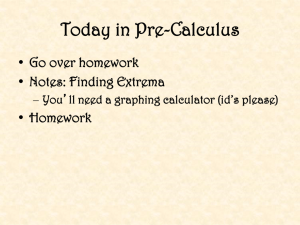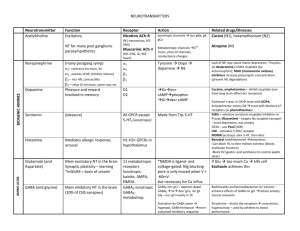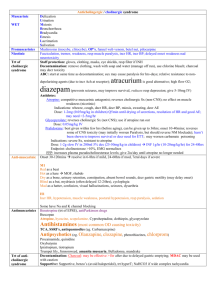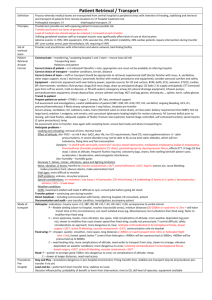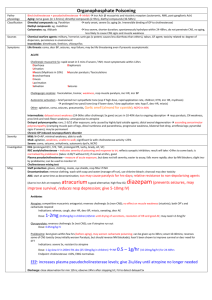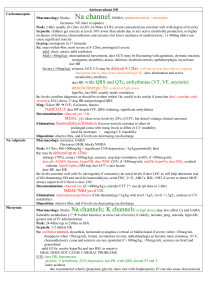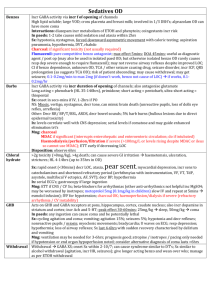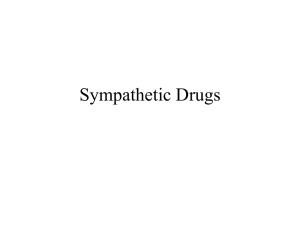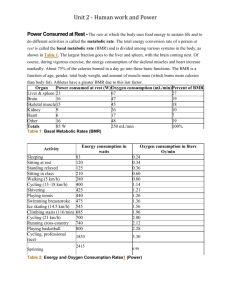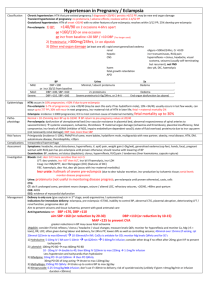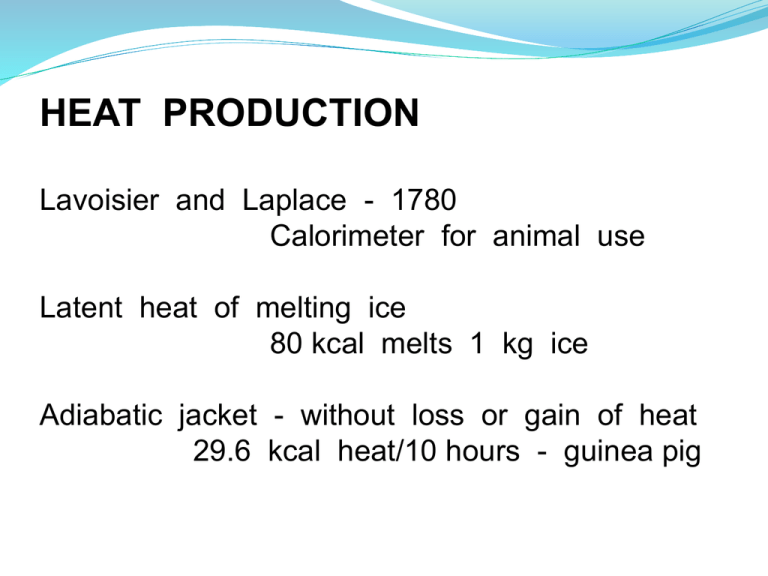
HEAT PRODUCTION
Lavoisier and Laplace - 1780
Calorimeter for animal use
Latent heat of melting ice
80 kcal melts 1 kg ice
Adiabatic jacket - without loss or gain of heat
29.6 kcal heat/10 hours - guinea pig
BOMB CALORIMETERS Heat of combustion - fuels, tissues, foods
Resulting increase - water temperature x specific
heat water x volume water (L) = calories
Burns all food >>> final oxidation product
ANIMAL / RESPIRATION CALORIMETERS
Atwater and Rosa - 1899
2 concentric copper walls
Adjusted mean temperature outer wall = mean temperature
inner wall
NO HEAT FLOW
Heat Loss = volume water passing through it, difference
in water temperature entering and leaving,
specific heat of water
DIRECT CALORIMETER : Problems
1) Expensive
2)
Size restriction
3)
Slow response time - much
slower than rate of heat
transfer from animal
INDIRECT CALORIMETRY
Less expensive, convenient
Measure oxygen consumed and carbon dioxide
Produced
Certain assumptions
2 TYPES OF INDIRECT CALORIMETERS
1) CLOSED - CIRCUIT
2)
OPEN - CIRCUIT
______________________________________________
CLOSED - CIRCUIT
Animal cut off from outside air
respirometer - spirometer - manometer
Expired CO2 - absorbed by soda lime or ascarite
H2O - absorbed by sulfuric acid or drierite
OPEN-CIRCUIT INDIRECT CALORIMETRY
Breathes air from outside
Exhaled air analyzed for volume and
content O2 and CO2
Rates of O2 and CO2 consumptions - calculated
Collection - respiratory gases
Gas tight masks, helmets, hoods,
trachial cannulation, chambers
FACTORS DETERMINING BASAL OR RESTING MR
BMR: Rested, awake, thermoneutral, fasted (may be
days for large animals)
•
Postabsorptive state difficult to achieve.
+ BMR may vary by 5%
Resting MR : Resting in thermoneutral zone - but not
postabsorptive
•
More convenient measurement
FACTORS TO EXCLUDE FROM ALL BMR TESTS:
1. Muscular movement
2. Recent muscular activity (1/2 to 1 hour)
3. Food within 12 - 14 hours (problem with ruminants)
4. Strong emotions, noises, discomfort
5. Extremes of Ta
6. Disease
7. Time of day
FACTORS TO ACCOUNT FOR IN INTERPRETATION
OF BMR
1.
Age
2.
Sexual state - (ex. estrus)
3.
Size and surface area
4.
Undernutrition and overnutrition
5.
Training
6.
Climate
7.
Circadian rhythm
8.
Altitude
9.
Sleep
10.
Body temperature
11.
Previous diet
12.
Novelty
13.
Time of year
SIZE AND SURFACE AREA
Smaller animal has greater heat loss than larger animal
Mouse and Cow comparison
Mouse has only small fraction of heat produced by cow in watts
But when expressed in terms of body mass
Mouse =
10 watt/kg
Cow
=
0.6 watt/kg
What is best expression MR for large & small animals
Surface area - better than body mass
WHY?
Rate of heat transfer proportional Surface Area
Surface Law:
MR proportional to SA (Kleiber)
Problem - Actual SA - poorly defined
Meeh - 1879 - used 6 adults & 10 children
SA = kW2/3
k specific for species
Two bodies with same density - SA proportional to
2/3
power of body mass
BUT - MR / BW2/3 is significantly correlated with
body weight (a problem)
Relationship - MR / BW.74 and body weight - insign.
Determined by Brody
BRODY - KLEIBER DISCUSSION
Brody - interspecific value of 0.734 predicted MR wide range - species
Rounded off to 0.7
Kleiber - determined 0.756 - rounded down to 0.75
He thought Brody's value too close to 0.67 for
surface area.
1935 - National Research Council adopted 0.73
Kleiber - noted that a significant difference
between 0.67 and 0.75 seen only over weight range of 9-fold or more.
1964 - European Energy Metabolism Symposium
adopted 0.75 for interspecific comparisons
Another Factor
Age
OTHER FACTORS AFFECTING METABOLISM
1. Activity Level
Lowest MR - normally during sleep - with
anesthetics can drop even lower
Birds - standing up >> 40 - 45% increase MR
Eating >> 37% increase in MR
2. Plane of Nutrition
At rest - heat production and heat loss - highly
dependent on mean rate of feed consumption
Increase nutrition level >>> increased metabolic rate
Sheep - heat production at TNZ directly related to food
intake
BUT - rate of increase - heat production at cold Ta - not affected by level of feeding
Pigs - even sham feeding >> increased heat production
Increase level of nutrition >> decr. LCT
ALSO - incr. level of nutrition >> decr. UCT
Thermal preference also shifted >> lower level
AGE
MR increases rapidly at first - then a decline
Cattle, horses, goats, and sheep - exponential decrease
in MR with age
Pig - less age-related change with age
Birds - TNZ - widens and shifts to a lower range of Ta
with age
MR increases with age - then declines for many
avian species
SEX OF ANIMAL
In general - female has approx. 10% lower MR than male
Due to greater proportion of subcutaneous fat
(greater insulation and less heat loss)
BUT - not true during production MR of white leghorn layers approx. 50%
greater per unit body weight than cockerels
Also an increase in dairy cows
Due to increased energetic cost of production .
CLIMATE - RACE - STRAIN
Galvao men (Brazil) - RMR approx. 10% below that
of north Americans and Europeans
1. Potential benefit
2.
Not sure if due to race or climate
3.BUT - individuals from temperate climate after moving to tropics - MR drops
approx. same magnitude
Humans - may "adapt" to thermal stress
by simply reducing the response
Australian aborigines - sleep at Ta
below 0°C - between small fires but without shelter
They did not shiver but were able to sleep
Tb never reached steady-state
Very economical
Kalahari bushmen - little clothing Ta near 0°C at night
Also do not shiver - and let Tb drop
Adipose tissue insulation much less important
Ama women divers (Korea)
Water temperature may fall to 10°C in winter.
Oral temperature may fall 2-4°C during dive.
Shivering is activated at lower Ta but less intense.
Cows - exposed to chronic heat >> decr. HP
HP decreases 18-20% spring > summer for Holstein heifers
Might be related to decrease in food intake
Ungulates - cold exposure (chamber) - short or long
periods >> incr. RMR
Also occurs naturally - sheep and cattle
May be some relationship - change - feed intake
Also occurs in birds
White leghorn hens - 22 >> 28°C decr. MR at 3 - 12 days
Incr. to 35°C >> decr. MR after 4 weeks
Also - MR - birds - highest in winter lowest in summer
+ summer-acclimatized layers have
higher UCT than winter-acclimatized layers
Pregnancy - human
6th month - pregnancy
MR begins to rise and continues until
delivery (20% above normal)
MR drops after birth by amount = newborn MR
• Mother's energy expenditure does not change
during pregnancy.

